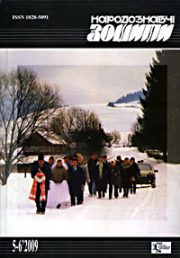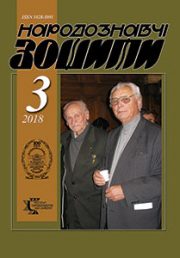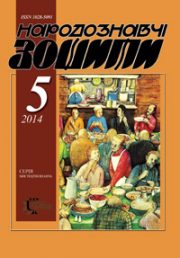The Ethnology Notebooks. 2025. № 5 (185), 1188—1198
UDK75.036:7.038.53(477)(4)”1950/1970″
COLLAGE AND TEXTURAL STRATEGIES OF KARLO ZVIRYNSKYI IN THE EUROPEAN ART CONTEXT OF THE 1950S—1970S
KUSHNIRUK Nataliia
- ORCID ID: https://orcid.org/0000-0002-8721-0865
- independent researcher, art critic, art curator,
- Contacts: е-mail: nk1016659@gmail.com
Abstract. The aim of the article is to identify and analyze the sources of the formation of Karl Zvirynsky’s collage and textural strategies in the context of European modernism of the 1950s—1970s, and to trace the ways of adapting these techniques in the conditions of Soviet Ukraine.
The relevance of the study is due to the need for a deeper understanding of the phenomenon of Ukrainian abstraction of the outlined period in interaction with European art, as well as the need to reconstruct those artistic channels through which modernist ideas penetrated the Soviet cultural space.
The appeal to collage and assemblage as components of K. Zvirynsky’s authorial language opens up new perspectives for the interpretation of Ukrainian art of the second half of the 20th century in a global dimension. It is shown that the formation of the artist’s abstract language took place in a complex interaction of local Galician traditions and international artistic trends.
It demonstrates that the artist’s abstract language was formed through the complex interaction of local Galician traditions and international artistic currents. Particular attention is given to the influence of Bauhaus color theories and European modernist experiments, which Zvirynsky reinterpreted through his own concept of material as a bearer of cultural memory.
The methodological basis of the study is a combination of art historical analysis with methods of iconology, formal and comparative analysis. The analysis is aimed at identifying parallels between the work of K. Zvirynsky and the practices of European modernism, in particular the avant-garde and neo-avant-garde movements.
Also important is the hermeneutic perspective, structuralism, and the concept of “archaeology of knowledge” by M. Foucault, which allows us to interpret his textural searches as a manifestation of spiritual experience and cultural memory.
The scientific novelty of the study lies in introducing the artist’s legacy into the broader European artistic discourse and in interpreting his abstraction as a practice of memory and spiritual reflection.
Keywords: Karlo Zvirynskyi, abstraction, collage, texture, modernism, nonconformism, cultural memory, avant-garde, Ukrainian art of the 20th century.
Received 4.09.2025
REFERENCES
- Zvirynska-Chaban, Kh. (Ed.). (2017). Zvirynsky Karlo. All my painting is prayer. Memories, interviews, reflections, articles. Lviv [in Ukrainian].
- Mysiuga, B. (2019). The hermetic circle of Karlo Zvirynskyi: Album-monograph. Lutsk; Lviv: MSUSK; LNAM; Kolo [in Ukrainian].
- Pavelchuk, I. (2009). Origins of Karlo Zvirynskyi’s abstract creativity. Modern art, 6, 366—370 [in Ukrainian].
- Bendiuk, M. (2024). Memories about the teacher — Volodymyr Antonovych Ovsiichuk. The Ethnology Notebooks, 6 (180), 1393—1396 [in Ukrainian].
- Kushniruk, N. (2023). «One apple of Cйzanne is worth more than all your socialist realism»: Karlo Zvirynskyi’s dissent within the totalitarian system. Retrieved from: https://litopys.info/articles/odne-yabluko-sezana-varte-bilshe-nizh-uves-vash-sotsrealizm-inakomyslennya-karla-zvirynskogo-v-mezhah-totalitarnoyi-systemy-natalya-kushniruk/ (Last accessed: 22.08.2025) [in Ukrainian].
- Krauss, R. (1985). The originality of the avant-garde and other modernist myths. Cambridge: MIT Press.
- Foucault, M., & Shovkun, V. (2003). Archaeology of knowledge. Kyiv: Osnovy [in Ukrainian].
- Blotnicka-Mazur, E. (2017) The Image of Art Between Ideology and Modernity. Elblag Biennales of Spatial Forms in 1960’s Poland. ARTis ON, 9, 97—106.
- Kohen, A. (2017). Giorgio Morandi’s beloved still lifes have unsettling ties to 20th century fascism. Retrieved from: https://www.artsy.net/article/artsy-editorial-giorgio-morandis-beloved-lifes-unsettling-ties-20th-century-fascism (Last accessed: 02.09.2025).
- (1996). Catalogue of lost exhibits of the National Museum in Lviv. Kyiv; Lviv [in Ukrainian].
- Ovsiichuk, V. (2015). Interview [Interview]. Retrieved from: https://www.youtube.com/watch?v=VvUatEG7b0U (Last accessed: 03.08.2025) [in Ukrainian].
- Rajmund Ziemski. Retrieved from: https://molskigallery.com/kolekcjaa/rajmund-ziemski (Last accessed: 03.09.2025) [in Polish].







